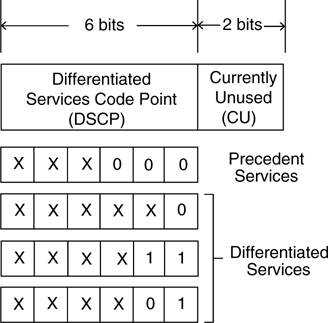6
IP QUALITY OF SERVICE
6.1 INTRODUCTION
The Internet was originally designed to provide best-effort service to existing applications. Nevertheless according to the original description of the Internet Protocol (IP), packets could receive different services as they pass over network nodes (now known as IP routers). Thus, packets would be able to receive, service differentiation or varying quality of service (QoS). With today’s voice and video applications, real-time services are increasingly in demand, and the varying levels of service raise the need for further traffic handling differentiation. This chapter discusses different issues and solutions proposed to provide this traffic service differentiation for IP networks.
6.2 QUALITY OF SERVICE IN IP VERSION 4
In IP version 4 (IPv4), a datagram header includes the type-of-service (TOS) field (8 bits) to indicate the service that the datagram may receive at supporting routers as originally defined in RFC791 [1]. The TOS bits provide the following choices:
- Bits 0-2: Precedence (111 = Network Control, 110 = Internetwork Control, 101 = CRITIC/ECP, 100 = Flash Override, 011 = Flash, 010 = Immediate, 001 = Priority, 000 = Routine)
- Bit 3: 0 = Normal Delay, 1 = Low Delay

Figure 6.1 Encoding in advanced marking scheme.
- Bit 4: 0 = Normal Throughput, 1 = High Throughput
- Bit 5: 0 = Normal Reliability, 1 = High Reliability
- Bit 6: 0 = Normal ...
Get Advanced Internet Protocols, Services, and Applications now with the O’Reilly learning platform.
O’Reilly members experience books, live events, courses curated by job role, and more from O’Reilly and nearly 200 top publishers.

